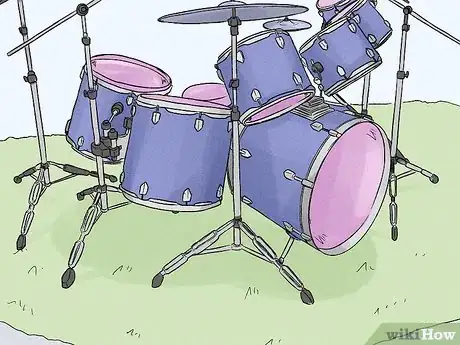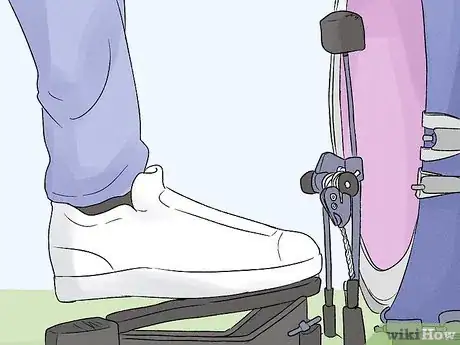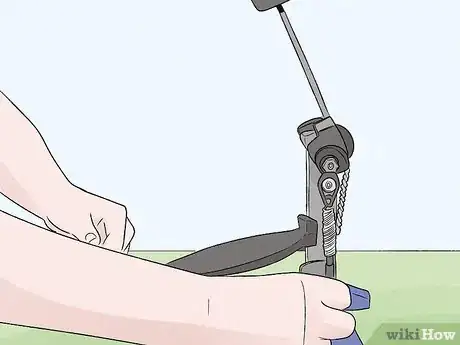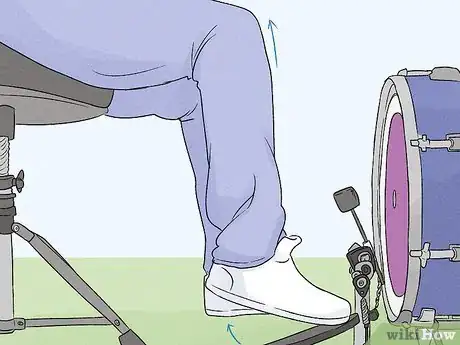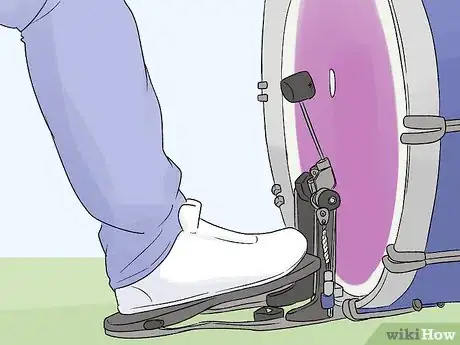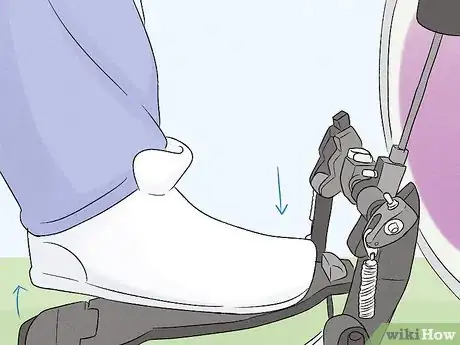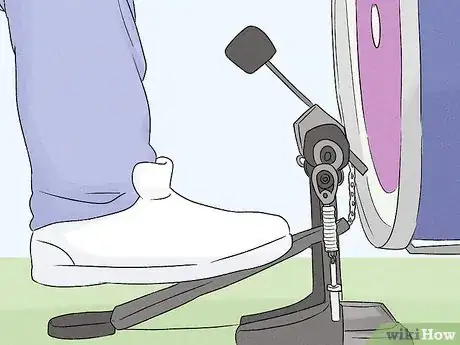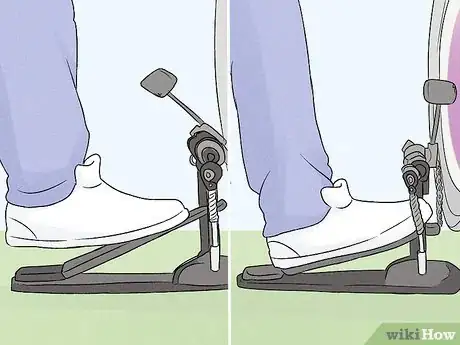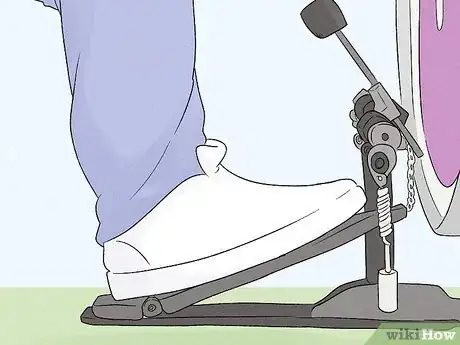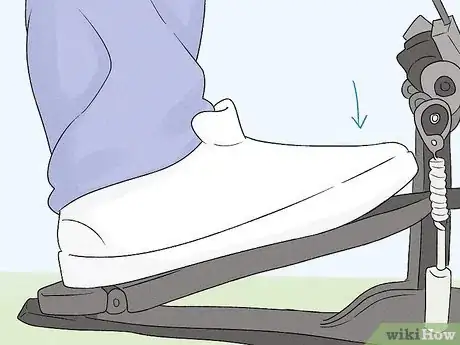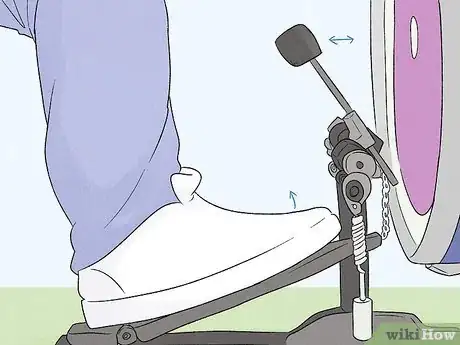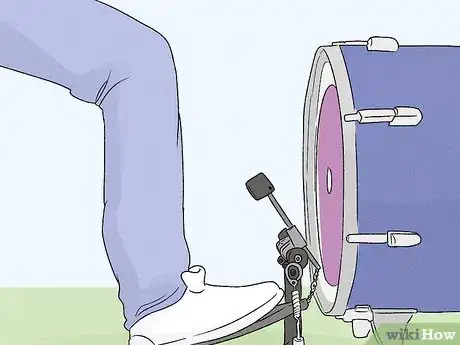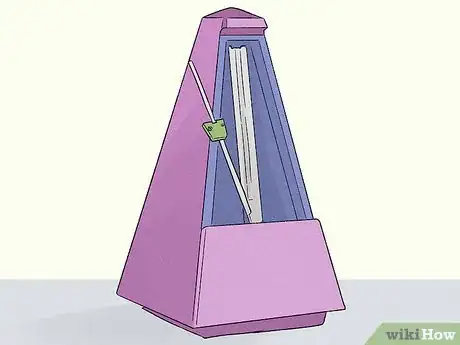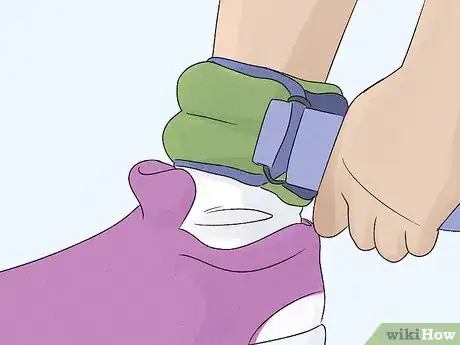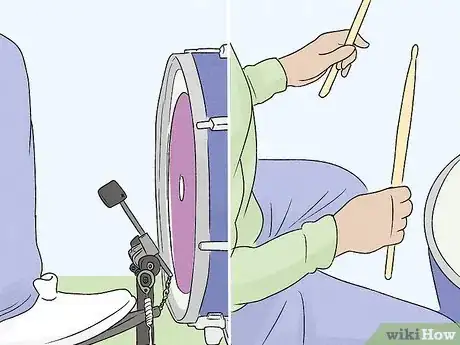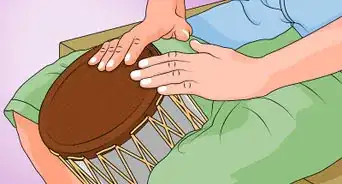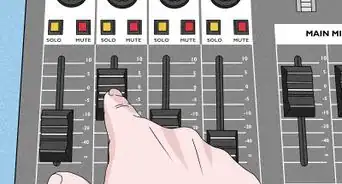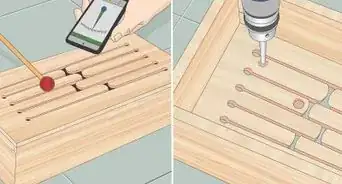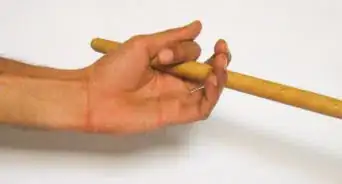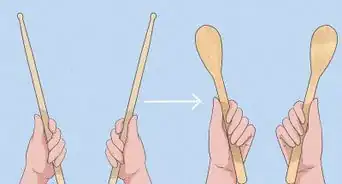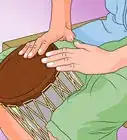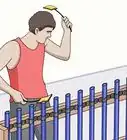This article was co-authored by wikiHow staff writer, Christopher M. Osborne, PhD. Christopher Osborne has been a wikiHow Content Creator since 2015. He is also a historian who holds a PhD from The University of Notre Dame and has taught at universities in and around Pittsburgh, PA. His scholarly publications and presentations focus on his research interests in early American history, but Chris also enjoys the challenges and rewards of writing wikiHow articles on a wide range of subjects.
There are 7 references cited in this article, which can be found at the bottom of the page.
This article has been viewed 18,947 times.
Learn more...
The kick drum (also called the bass drum) isn’t the “showy” part of a drum kit, but it’s essential in creating the right sound for jazz, rock, and many other musical styles. You play the kick drum by pressing down on a pedal with your foot, so it’s important to position yourself and your gear properly before practicing. Once you’re ready to play, practice “heel up” and “heel down” techniques until you develop the muscle memory, stamina, and style needed to bang out some great music!
Steps
Positioning the Equipment
-
1Set up your kit on a stable, non-slip surface. If you set up on an uneven or slick surface, your drum kit will slowly slide away from you—or even tip over completely—while you play. For the best results, lay a cushioned drum mat on a solid, level surface to create a base for your kit.[1]
- Drum mats are available anywhere drum kits and supplies are sold.
- Alternatively, use a thick rug that helps hold the kit in place.
- Placing the kit on uncovered wood or tile may cause damage to the floor.
-
2Adjust your seat so your thighs are parallel to the floor. Seating height should be personalized based on feel, but start out at this neutral position. If you sit too high or too low, your leg muscles will tire more quickly as you practice.[2]
- Use a comfortable seat that gives your legs a full range of movement.
- Some drummers prefer a backless stool, while others opt for a backed chair. Either way, drummers are often very particular about their “drum thrones!”
Advertisement -
3Set the pedal where your dominant foot naturally rests. Sit down at the drum kit without the foot pedal in place, making sure that your arms can comfortably reach all the kit’s upper drums. Take note of where your dominant foot—the one you’ll drum with—is resting flat on the floor, and set up the pedal so it is at this spot and aligned with the bass drum.[3]
- The pedal used to play a kick drum looks a bit like a car’s gas pedal connected to a swinging mallet (the “beater”) with a series of chains and springs. Pressing down on the pedal causes the beater to swing forward and strike the drum.
-
4Adjust the beater angle and spring tension to suit you. Once you have the pedal in the right position, set the beater’s angle so that it strikes the drum fully when you press down on the pedal. At the same time, adjust the spring tension to fine-tune the amount of downward force you need to make on the pedal.[4]
- Check the product manual for your pedal to determine how to adjust the beater angle and spring tension.
- As a beginner, aim to have the beater at a 45-degree angle to the drum’s face and the floor when it’s in a resting position. Setting the spring tension to its medium range is also a good starting point for a novice.
- Taking the time to set up properly doesn’t seem like much fun when all you want to do is blast away on your new drum kit! But it’s worth the time and effort—you’ll learn more quickly and be able to play longer before getting sore.
Playing “Heel Up” and Variations
-
1Lift your knee and heel while keeping your toes on the pedal. “Heel up” and “heel down” technique both start the same way—with your entire foot flat on the pedal. For “heel up,” though, keep the ball of your foot on the pedal as you lift your heel and knee in one motion. Don’t press down on the pedal with your toes just yet.[5]
- While “heel down” technique feels a bit more natural at the start, “heel up” is more commonly used because you can play louder and at a faster tempo. “Heel up” works with any type of music, and it’s definitely the technique of choice for rock drummers.
-
2Press your whole foot on the pedal to play a note. Drop your knee so that your heel makes contact with the pedal again. As your heel makes contact, press down on the front of the pedal with your toes and the balls of your feet. The beater will swing up, make contact with the drum, and play a single note.[6]
- As soon as the beater strikes the drum, return to the “lift” position—knee and heel raised, toes on the pedal but not pressing down on it. Keep your foot pressed down for an instant after contact only if you want to “bury the beater” and deaden the sound of the note.
-
3Push your toes down while lifting your heel to play a double note. While lifting your knee and heel, press down on the pedal only with your toes—this plays the first note. Lift your toes slightly just as you begin to bring your knee and heel down, then press down with your entire foot to play the second note.[7]
- Getting the timing right here definitely takes practice, but this is a clear advantage of “heel up” versus “heel down” technique—playing double (and even triple or quadruple) notes is more manageable.
-
4Use the “skip” to play multiple notes by tapping your toes. The “skip” maneuver is a variation on the “heel up” technique that involves lifting up and tapping down your toes in quick succession on the pedal. As you lift and drop your knee and heel, “skip” your toes back and then forward on the pedal to play multiple notes. Press down with each toe tap to play a note.[8]
- With practice, you may be able to play 3 or even 4 notes with one up-and-down leg movement!
-
5Try the “heel-toe” as another variation for playing multiple notes. As you’re about to drop your knee and heel down, tap out a note with your toes. Then, lift your toes just enough that you play the second note only with your heel. As you start to lift your heel up, tap your toes down to play a third note in quick succession.[9]
- With lots of practice, some drummers can even squeeze in another heel tap and play 4 notes with a single leg movement.
- Remember—banging on a kick drum is easy, but really playing a kick drum takes practice!
Using the “Heel Down” Technique
-
1Put your whole playing foot flat on the pedal. When using “heel down” technique, your toes should always be in contact with the toe end of the pedal, and your heels always in contact with the heel end. Because of the angle of the pedal, this means that your toes will be elevated a few inches/centimeters above your heels.[10]
- This technique is called “heel down” precisely because your heel will remain essentially at floor level the entire time.
- “Heel down” is the instinctual way that most people play a kick drum the first time, but pros more commonly play “heel up” because it gives them greater volume and tempo range. “Heel down” is often used by jazz drummers, though.
-
2Push your toes down without lifting your heel or knee. Your ankle is the pivot point in “heel down” technique, meaning that your heel remains virtually still while the front section of your foot lifts up and presses down. You should also see very little movement in your knee or upper leg, since your shin muscles are doing most of the work.[11]
- Expect your shins to get sore quickly! “Heel down” drumming is actually a great shin muscle-building exercise, but it will take some time to develop your shin strength. Take frequent rest breaks while practicing, and put off practicing if your shin is anything more than mildly sore.
- As you press down on the pedal, the beater will swing forward and strike the drum’s face.
-
3Lift your toes so the beater rebounds off of the drum. If you keep your foot pressed down on the pedal after the beater strikes the drum, you’ll “bury the beater”—that is, keep it pressed against the drum. Instead, work on lifting the front of your foot as soon as you hear the beater strike the drum. This provides greater reverberation and a fuller sound.[12]
- “Burying the beater” is a useful technique to learn, but it’s better as a novice to learn how not to do it first.
- Letting the beater rebound off the drum also slightly reduces the strain put on your shins. You’ll really appreciate this when your shins start aching!
-
4Relax your shin muscle for an instant before the next beat. As you lift your toes in order to avoid “burying the beater,” quickly relax the muscle tension on your shin a bit. You may only get a fraction of a second of rest before it’s time to press down for the next beat, but that may be enough to keep your shins from getting too sore.[13]
- Keeping constant muscle tension on your shin while drumming may contribute to painful shin splints.
Building Your Skills and Stamina
-
1Practice with a metronome to work on your tempo. Getting and keeping the right tempo is essential when playing a kick drum. A metronome is a great tool for staying on tempo, especially when you’re a beginner working to master “heel down” and/or “heel up” drumming.[14]
- Both digital and mechanical metronomes will work. Because the drum will drown out the sound of the metronome, though, make sure you position it so that you can clearly see its swinging arm (mechanical) or blinking lights (digital).
- The metronome will continue to be useful as you work on playing at faster tempos.
-
2Use ankle weights to build up strength, stamina, and speed. “Heel down” technique is more taxing on your shins in particular, but both it and “heel up” playing give your leg muscles a major workout. To help build strength, stamina, and speed, try putting on ankle weights when you practice.[15]
- When you take off the weights, your feet will feel light as a feather and you’ll think you can play twice as fast!
- Look for ankle weights at any fitness retailer.
-
3Rest your muscles while playing and during regular breaks. Take every chance to rest your leg muscles even for a millisecond while practicing and playing. Release muscle tension very briefly between playing notes whenever you get the chance. You’ll be able to practice longer without getting as sore![16]
- In addition, listen to your body and rest frequently while practicing. If your leg is uncomfortably sore, take a break for a day or two.
-
4Practice arm and leg movements separately before bringing it all together. Let’s face it—you can’t really call yourself a drummer until you can play the entire kit at once! In order to reach that point, focus on mastering each element of the kit separately. For example, practice just the kick drum until you’re completely comfortable with your ability to maintain tempo, power, and control for long periods.[17]
- It takes time to develop the muscle memory needed to play with your arms and legs at the same time, and to build the stamina to keep it up for longer periods. Don’t be discouraged!
References
- ↑ https://www.thenewdrummer.com/effective-bass-drum-technique/
- ↑ https://www.moderndrummer.com/article/august-2018-drumset-ergonomics-part-2-seat-height/
- ↑ https://www.thenewdrummer.com/effective-bass-drum-technique/
- ↑ https://www.thenewdrummer.com/effective-bass-drum-technique/
- ↑ https://youtu.be/umCyH6l0i08?t=320
- ↑ https://youtu.be/umCyH6l0i08?t=320
- ↑ https://youtu.be/umCyH6l0i08?t=320
- ↑ https://tomtommag.com/2016/12/multi-part-technique-series-focus-bass-drum-part-pedal-techniques/
- ↑ https://tomtommag.com/2016/12/multi-part-technique-series-focus-bass-drum-part-pedal-techniques/
- ↑ https://tomtommag.com/2016/12/multi-part-technique-series-focus-bass-drum-part-pedal-techniques/
- ↑ https://youtu.be/umCyH6l0i08?t=125
- ↑ https://youtu.be/umCyH6l0i08?t=125
- ↑ https://tomtommag.com/2016/12/multi-part-technique-series-focus-bass-drum-part-pedal-techniques/
- ↑ https://takelessons.com/blog/boost-your-bass-drum-z07
- ↑ https://youtu.be/FArpzF1Sn68?t=1050
- ↑ https://youtu.be/FArpzF1Sn68?t=1050
- ↑ https://tomtommag.com/2016/12/multi-part-technique-series-focus-bass-drum-part-pedal-techniques/
